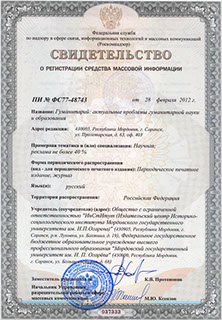Navigation
ISSN 2078-9823 (Print), ISSN 2587-7879 (Online)
DOI: 10.15507/2078-9823.042.018.201802.133-141
Yulduz A. Gaybullaeva
National University of Uzbekistan (Tashkent, Uzbekistan),
e-mail: Yulduz-karimova@yandex.ru
ORCID: https://orcid.org/0000-0002-3352-0315.
THE CUSTOMS AND CEREMONIES CONNECTED WITH NATIONAL UZBEK CLOTHES (the end of XIX – the beginning of XX)
Introduction. The history of national Uzbek clothing originates from ancient times and for each region has its own characteristics. Clothing, besides aesthetic functions, meets climatic condi-tions and tribal traditions. The purpose of the article is to represents national Uzbek clothes that reflect the traditions withdraw the roots to ethnic history of the people, the social relations, beliefs, esthetic ideals. The leading approach to the study of this problem is the analysis of everyday, ritual clothing, which makes it possible to reveal the peculiarities of customs and rituals associated with national clothes. Materials and Methods. For the detailed study of information by the author, vari-ous methods were used. The comparative-historical method makes it possible to reveal the tenden-cies in the formation of the historical process, to penetrate into the essence of phenomena. It as-sumes the typologization of historical phenomena, which determines their essential characteristics from secondary, optional. Results and Discussion. I made an analysis of the question, it was estab-lished that concludes that historical development of national women’s clothing closely connected with natural, economic conditions of an era, esthetic and moral requirements, the general art style, separate events. At the end of the 19th century the national women’s suit in Uzbekistan remained generally traditional. The traditional clothes defined an ethnic origin of the woman, her social and marital status, age. An obligatory component of the female costume was jewelry made of gold or silver. Earrings, pendants, bracelets and rings, had the appearance of “tumors” – “charms”, the presence of a non-sewn traditional oriental pattern, made in order to emphasize the marital status and status of women. Conclusion. Many features of national clothes connected with certain beliefs and representations. It is established that ethno-design is a means of aesthetic development of the individual and is necessary for the accumulation of traditional cultural experience. Modern con-structivism and traditions of folk art, at first glance, seem to be an attempt to unite the incompati-ble. Modern design is the product of a new stage in the development of civilization, the causes and consequences of industry and commerce in the aggregate.
Keywords: women’s costume, dresses, headgear, jewelry decorations, elements of decor.
For citation: Yulduz A. Gaybullaeva. The Customs and Ceremonies Connected with National Uzbek Clothes (end of XIX – beginning of XX). Gumanitarian : aktual’nye problemy gumanitarnoi nauki i obrazovaniia = Russian Journal of the Humanities. 2018; 18(2): 133–141. (In Russ.). DOI: 10.15507/2078-9823.042.018.201802.133-141

© Ogarev Mordovia State University. History and Sociology Institute, 2017
68, Of. 411, Bolshevistskaya St., 430005, The editorial office of the scholarly journal «Russian Journal of the Humanities»
Tel.: (8342) 24-25-90; 27-07-11, Fax: (8342) 24-25-90, E-mail: jurnal-econom-hist@isi.mrsu.ru
Designed by A. Napalkov, Email: napalkov@isi.mrsu.ru

